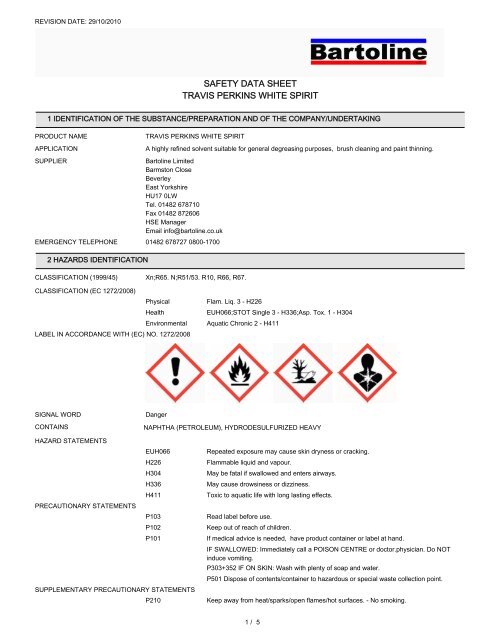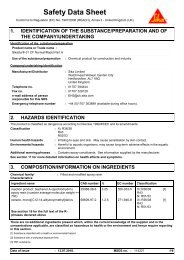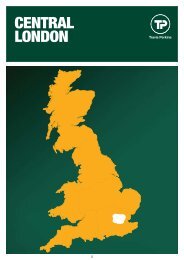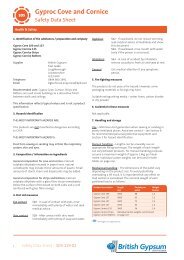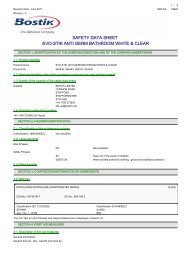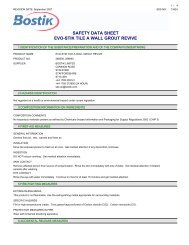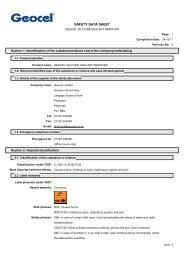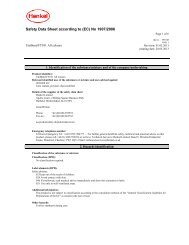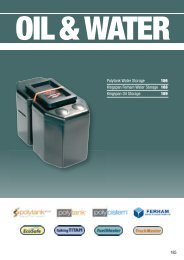SAFETY DATA SHEET TRAVIS PERKINS WHITE SPIRIT
SAFETY DATA SHEET TRAVIS PERKINS WHITE SPIRIT
SAFETY DATA SHEET TRAVIS PERKINS WHITE SPIRIT
- No tags were found...
Create successful ePaper yourself
Turn your PDF publications into a flip-book with our unique Google optimized e-Paper software.
REVISION DATE: 29/10/2010<strong>SAFETY</strong> <strong>DATA</strong> <strong>SHEET</strong><strong>TRAVIS</strong> <strong>PERKINS</strong> <strong>WHITE</strong> <strong>SPIRIT</strong>1 IDENTIFICATION OF THE SUBSTANCE/PREPARATION AND OF THE COMPANY/UNDERTAKINGPRODUCT NAMEAPPLICATIONSUPPLIER<strong>TRAVIS</strong> <strong>PERKINS</strong> <strong>WHITE</strong> <strong>SPIRIT</strong>A highly refined solvent suitable for general degreasing purposes, brush cleaning and paint thinning.Bartoline LimitedBarmston CloseBeverleyEast YorkshireHU17 0LWTel. 01482 678710Fax 01482 872606HSE ManagerEmail info@bartoline.co.ukEMERGENCY TELEPHONE 01482 678727 0800-17002 HAZARDS IDENTIFICATIONCLASSIFICATION (1999/45) Xn;R65. N;R51/53. R10, R66, R67.CLASSIFICATION (EC 1272/2008)PhysicalHealthEnvironmentalLABEL IN ACCORDANCE WITH (EC) NO. 1272/2008Flam. Liq. 3 - H226EUH066;STOT Single 3 - H336;Asp. Tox. 1 - H304Aquatic Chronic 2 - H411SIGNAL WORDCONTAINSDangerNAPHTHA (PETROLEUM), HYDRODESULFURIZED HEAVYHAZARD STATEMENTSEUH066H226H304H336H411PRECAUTIONARY STATEMENTSP103P102P101SUPPLEMENTARY PRECAUTIONARY STATEMENTSP210Repeated exposure may cause skin dryness or cracking.Flammable liquid and vapour.May be fatal if swallowed and enters airways.May cause drowsiness or dizziness.Toxic to aquatic life with long lasting effects.Read label before use.Keep out of reach of children.If medical advice is needed, have product container or label at hand.IF SWALLOWED: Immediately call a POISON CENTRE or doctor.physician. Do NOTinduce vomiting.P303+352 IF ON SKIN: Wash with plenty of soap and water.P501 Dispose of contents/container to hazardous or special waste collection point.Keep away from heat/sparks/open flames/hot surfaces. - No smoking.1 / 5
REVISION DATE: 29/10/2010P261<strong>TRAVIS</strong> <strong>PERKINS</strong> <strong>WHITE</strong> <strong>SPIRIT</strong>Avoid breathing dust/fume/gas/mist/vapours/spray.P304/340 IF INHALED: Remove victim to fresh air and keep at rest in a position comfortable forbreathing.P331Do NOT induce vomiting.3 COMPOSITION/INFORMATION ON INGREDIENTSNAPHTHA (PETROLEUM), HYDRODESULFURIZED HEAVY 60-100%CAS-No.: 64742-82-1 EC No.: 265-185-4CLASSIFICATION (EC 1272/2008)Flam. Liq. 3 - H226EUH066STOT Single 3 - H336Asp. Tox. 1 - H304Aquatic Chronic 2 - H411CLASSIFICATION (67/548)Xn;R65.N;R51/53.R10,R66,R67.The Full Text for all R-Phrases and Hazard Statements are Displayed in Section 164 FIRST-AID MEASURESGENERAL INFORMATIONMove the exposed person to fresh air at once. Get medical attention if any discomfort continues.INHALATIONMove the exposed person to fresh air at once. Get medical attention. Provide rest, warmth and fresh air. When breathing is difficult,properly trained personnel may assist affected person by administering oxygen.INGESTIONDO NOT INDUCE VOMITING! NEVER MAKE AN UNCONSCIOUS PERSON VOMIT OR DRINK FLUIDS! If vomiting occurs, keep headlow so that stomach content doesn't get into the lungs. Drink plenty of water. Get medical attention immediately! Provide rest, warmth andfresh air.SKIN CONTACTRemove contaminated clothing. Wash the skin immediately with soap and water. Get medical attention promptly if symptoms occur afterwashing.EYE CONTACTMake sure to remove any contact lenses from the eyes before rinsing. Promptly wash eyes with plenty of water while lifting the eye lids.Continue to rinse for at least 15 minutes and get medical attention.5 FIRE-FIGHTING MEASURESEXTINGUISHING MEDIAFire can be extinguished using: Foam. Dry chemicals, sand, dolomite etc.SPECIAL FIRE FIGHTING PROCEDURESAvoid breathing fire vapours. Cool containers exposed to flames with water until well after the fire is out. Keep run-off water out of sewersand water sources. Dike for water control.SPECIFIC HAZARDSVapours are heavier than air and may travel along the floor and in the bottom of containers. Vapours may be ignited by a spark, a hotsurface or an ember.6 ACCIDENTAL RELEASE MEASURESPERSONAL PRECAUTIONSWear protective clothing as described in Section 8 of this safety data sheet.ENVIRONMENTAL PRECAUTIONSSpillages or uncontrolled discharges into watercourses must be IMMEDIATELY alerted to the Environmental Agency or other appropriateregulatory body.SPILL CLEAN UP METHODSWear necessary protective equipment. Absorb in vermiculite, dry sand or earth and place into containers. Do not contaminate watersources or sewer.2 / 5
REVISION DATE: 29/10/2010<strong>TRAVIS</strong> <strong>PERKINS</strong> <strong>WHITE</strong> <strong>SPIRIT</strong>10 STABILITY AND REACTIVITYSTABILITYStable under normal temperature conditions.CONDITIONS TO AVOIDAvoid contact with acids and oxidising substances.HAZARDOUS DECOMPOSITION PRODUCTSFire creates: Toxic gases/vapours/fumes of: Carbon monoxide (CO). Carbon dioxide (CO2).11 TOXICOLOGICAL INFORMATIONINHALATIONProlonged inhalation of high concentrations may damage respiratory system.INGESTIONLiquid irritates mucous membranes and may cause abdominal pain if swallowed.SKIN CONTACTActs as a defatting agent on skin. May cause cracking of skin, and eczema. Prolonged or repeated exposure may cause severe irritation.EYE CONTACTMay cause severe irritation to eyes.OTHER HEALTH EFFECTSHarmful: if swallowed accidentally, the product may enter the lungs due to its low viscosity and lead to the rapid development of veryserious pulmonary lesions )medical survey for 48 hours min).TARGET ORGANSSkin Eyes Respiratory system, lungs12 ECOLOGICAL INFORMATIONECOTOXICITYDangerous for the environment: May cause long-term adverse effects in the aquatic environment.MOBILITYThe product is insoluble in water and will spread on the water surface.BIOACCUMULATIONMay accumulate in soil and water systems.DEGRADABILITYThe product is expected to be slowly biodegradable.13 DISPOSAL CONSIDERATIONSGENERAL INFORMATIONWaste is classified as hazardous waste. Disposal to licensed waste disposal site in accordance with the local Waste Disposal Authority.Waste is suitable for incineration. Waste is classified as hazardous waste. Disposal to licensed waste disposal site in accordance with thelocal Waste Disposal Authority. Rags and the like, moistened with flammable liquids, must be discarded into designated fireproof bucket.DISPOSAL METHODSDispose of waste and residues in accordance with local authority requirements. Do not allow runoff to sewer, waterway or ground. Emptycontainers must not be burned because of explosion hazard. Recover and reclaim or recycle, if practical.14 TRANSPORT INFORMATIONUK ROAD CLASS 3PROPER SHIPPING NAMETURPENTINE SUBSTITUTE (White Spirit)4 / 5
REVISION DATE: 29/10/2010ROAD TRANSPORT NOTES<strong>TRAVIS</strong> <strong>PERKINS</strong> <strong>WHITE</strong> <strong>SPIRIT</strong>Limited quantity size 5 litresUN NO. ROADADR CLASS NO.ADR PACK GROUP13003IIIUK ROAD PACK GR.ADR CLASSTUNNEL RESTRICTION CODEHAZARD No. (ADR) 30ADR LABEL NO.3HAZCHEM CODE3YCEFIC TEC(R) NO.RID CLASS NO. 3UN NO. SEA1300IMDG CLASS3IMDG PACK GR.EMS F-E, S-EUN NO. AIR1300AIR CLASS15 REGULATORY INFORMATION3AIR PACK GR.IIIClass 3: Flammable liquids.(D/E)30G30IIIIIIUK REGULATORY REFERENCESHealth and Safety at Work Act 1974. The Control of Substances Hazardous to Health Regulations 2002 (S.I 2002 No. 2677) withamendments. Chemicals (Hazard Information & Packaging) Regulations.ENVIRONMENTAL LISTINGControl of Pollution Act 1974. Control of Pollution (Special Waste Regulations) Act 1980.STATUTORY INSTRUMENTSThe Chemicals (Hazard Information and Packaging for Supply) Regulations 2009 (S.I 2009 No. 716).APPROVED CODE OF PRACTICEClassification and Labelling of Substances and Preparations Dangerous for Supply.GUIDANCE NOTESWorkplace Exposure Limits EH40. Introduction to Local Exhaust Ventilation HS(G)37. CHIP for everyone HSG(108).NATIONAL REGULATIONSUsers of this product are reminded of their duties under the current Control of Substances Hazardous to Health Regulations and a suitableand sufficient assessment of all the risk should be undertaken before using this product. The guidelines given in the HSE publicationCOSHH ESSENTIALS - Easy Steps To Control Chemicals gives sound advice for deciding safe working control measures.16 OTHER INFORMATIONREVISION DATE 29/10/2010REV. NO./REPL. SDS GENERATED 3RISK PHRASES IN FULLR10Flammable.R51/53Toxic to aquatic organisms, may cause long-term adverse effects in the aquatic environment.R65Harmful: may cause lung damage if swallowed.R66Repeated exposure may cause skin dryness or cracking.R67Vapours may cause drowsiness and dizziness.HAZARD STATEMENTS IN FULLEUH066Repeated exposure may cause skin dryness or cracking.H226Flammable liquid and vapour.H304May be fatal if swallowed and enters airways.H336May cause drowsiness or dizziness.H411Toxic to aquatic life with long lasting effects.DISCLAIMERThe information contained in this data sheet is provided in accordance with the requirements of the Chemicals (Hazard Information and Packaging forSupply) Regulations. The product should not be used for purposes other than those shown in Section 1. As the specific conditions of use are outside thesuppliers control, the user is responsible for ensuring that the requirements of relevant legislation are complied with. The information contained in thissafety data sheet is based on the present knowledge and the current UK legislation and EC Directive 91/155EC. It provides guidance on health, safetyand environmental aspects of the product and should not be taken as a product specification.5 / 5


